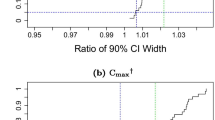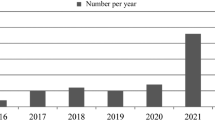Abstract
Purpose. The FDA has proposed replacing the current averagebioequivalence criterion with population and individual bioequivalence criteriathat consider variances in addition to the difference of averages. Oneof these variances in the individual bioequivalence criterion measuressubject-by-formulation interaction, the extent to which thetest-reference difference varies from person to person. This paper discussesconceptual and statistical issues raised in various publications andpresentations with respect to the presence and estimation of such aninteraction.
Methods. We focus on the importance of subject-by-formulationinteraction, an understanding of what is a large interaction, and theassessment of the magnitude of this interaction in bioequivalence studies.Simulation studies, examples from the literature, and data from FDAfiles are used to demonstrate the magnitude of the interaction and itsdistribution under various conditions.
Results. The concept of a large interaction is tied to the concept of alarge mean difference. We suggest that an interaction greater than0.15 is a conservative criterion for a large interaction. Magnitudes ofestimated interaction are affected by variability, sample size, and theselection of data sets that pass average bioequivalence.
Conclusions. Examples of substantial interactions are beginning toappear. More data is needed before reaching definitive conclusionsregarding the frequency and importance of observed interactions.
Similar content being viewed by others
REFERENCES
D. J. Schuirmann. A comparison of the two one-sided tests procedure and the power approach for assessing the bioequivalence of average bioavailability. J. Pharmacokinet. Biopharm. 15:657–680 (1987).
S. Anderson and W. W. Hauck. Consideration of individual bioequivalence. J. Pharmacokinet. Biopharm. 18:259–273 (1990).
W. W. Hauck and S. Anderson. Types of Bioequivalence and related statistical considerations. Int. J. Clin. Pharmacol. Ther. Toxicol. 30:181–187 (1992).
R. Schall and R. L. Williams for the FDA Individual Bioequivalence Working Group. Towards a practical strategy for assessing individual bioequivalence. J. Pharmacokinet. Biopharm. 24:133–149 (1996).
R. N. Patnaik, L. J. Lesko, M.-L. Chen, R. L. Williams, and the FDA Individual Bioequivalence Working Group. Individual bioequivalence: New concepts in the statistical assessment of bioequivalence metrics. Clin. Pharmacokinet. 33:1–6 (1997).
M.-L. Chen, R. N. Patnaik, W. W. Hauck, D. J. Schuirmann, T. Hyslop, R. L. Williams, and the FDA Population/Individual Bioequivalence Working Group. An individual bioequivalence criterion: Regulatory considerations. Statist. Med. in press.
Food and Drug Administration. In Vivo Bioequivalence Studies Based on Population and Individual Bioequivalence Approaches. Federal Register, December 1997.
Food and Drug Administration. Average, Population, and Individual Approaches to Establishing Bioequivalence. Federal Register, September 1999.
L. B. Sheiner. Bioequivalence revisited. Statist Med 11:1777–1788 (1992).
R. Schall and H. G. Luus. On population and individual bioequivalence. Statist. Med. 12:1109–1124 (1993).
D. J. Holder and F. Hsuan. Moment-based criteria for determining bioequivalence. Biometrika 80:835–846 (1993).
L. Endrenyi. A method for the evaluation of individual bioequivalence. Int. J. Clin. Pharmacol. Ther. Toxicol. 32:497–508 (1994).
V. M. Chinchilli. The assessment of individual and population bioequivalence. J. Biopharm. Statist. 6:1–14 (1996).
S. Hwang, P. B. Huber, M. Hesney, and K. C. Kwan. Bioequivalence and interchangeability (letter). J. Pharm. Sci. 67: iv (1978).
J. D. Haynes. Statistical simulation study of new proposed uniformity requirement for bioequivalence studies. J. Pharm. Sci. 70:673–675 (1981).
G. Ekbohm and H. Melander. The subject-by-formulation interaction as a criterion for interchangeability of drugs. Biometrics 45:1249–1254 (1989).
L. Endrenyi, G. L. Amidon, K. K. Midha, and J. P. Skelly. Individual bioequivalence: Attractive in principle, difficult in practice. Pharm. Res. 15:1321–1325 (1998).
L. Endrenyi and L. Tothfalusi. Subject-by-formulation interaction in determinations of individual bioequivalence: Bias and prevalence. Pharm. Res. 16:186–188 (1999).
L. Endrenyi, N. Taback, and L. Tothfalusi. Properties of the estimated variance component for subject-by-formulation interaction in studies of individual bioequivalence. Statist. Med., in press.
N. T. Longford. Selection bias and treatment heterogeneity in clinical trials. Statist Med 18:1467–1474 (1999).
B. L. Carter, M. A. Noyes, and R. W. Demmler. Differences in serum concentration of and responses to generic verapamil in the elderly. Pharmacotherapy 13:359–368 (1993).
M.-L. Chen, S.-C. Lee, M.-J. Ng, and D. J. Schuirmann. Gender analysis of bioequivalence trials. American Society for Clinical Pharmacology and Therapeutics, Ninety-ninth Annual Meeting, New Orleans, Louisiana, March 30-April 1, 1998.
V. M. Chinchilli and J. D. Esinhart. Design and analysis of intra-subject variability in cross-over experiments. Statist. Med. 1619–1634 (1996).
L. Z. Benet and J. E. Goyan. Bioequivalence and narrow therapeutic index drugs. Pharmacotherapy 15:433–440 (1995).
R. Simon. Confidence intervals for reporting results of clinical trials. Ann. Intern. Med. 105:429–435 (1986).
L. E. Braitman. Confidence intervals assess both clinical significance and statistical significance. Ann. Intern. Med. 114:515–517 (1991).
S. N. Goodman and J. A. Berlin. The use of predicted confidence intervals when planning experiments and the misuse of power when interpreting results. Ann. Intern. Med. 121:200–206 (1994).
W. W. Hauck and S. Anderson. A new statistical procedure for testing equivalence in two-group comparative bioavailability trials. J. Pharmacokinet. Biopharm. 12:83–91 (1984).
Author information
Authors and Affiliations
Rights and permissions
About this article
Cite this article
Hauck, W.W., Hyslop, T., Chen, ML. et al. Subject-by-Formulation Interaction in Bioequivalence: Conceptual and Statistical Issues. Pharm Res 17, 375–380 (2000). https://doi.org/10.1023/A:1007508516231
Issue Date:
DOI: https://doi.org/10.1023/A:1007508516231




